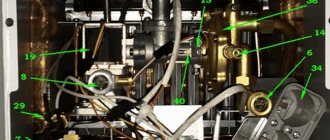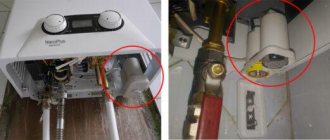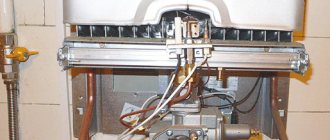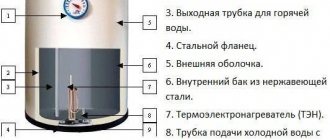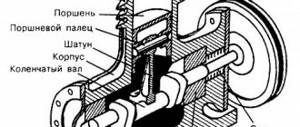A gas water heater is a necessary device in any apartment. It doesn’t need much time to heat the water and does the job very quickly. First of all, you need to remember that a geyser, like any device with gas, is a high-risk device. It ensures the supply of hot water to the house as a result of gas combustion.
After installation, you need to know how to properly start the gas water heater.
How does a gas water heater work?
Any user must understand how a gas water heater works. This is necessary for correct and safe use.
The speaker contains a metal casing, as well as:
The device can be installed both in the kitchen and in any non-residential premises with a ceiling height of at least two meters. In addition, the ventilation in the room must work properly.
Important! It is prohibited to place a gas water heater above the stove.
Gas devices of the Beretta, Electrolux and Neva brands operate in the same way:
- When turned on, water enters the system;
- Due to pressure, the membrane stretches and opens the gas supply valve;
- The burner is ignited, which begins to heat the liquid circulating through the heat exchanger;
- Combustion products are removed through the chimney and ventilation.
There is an opinion that installing a geyser is unsafe. This was during the time of using a device with manual ignition. Currently, the devices have sensors that control water heating and draft in order to prevent an emergency. However, do not forget about safety rules.
If you notice the smell of gas in your apartment, you must:
- Close the gas supply valve;
- Open window;
- Do not turn on electrical devices until the room no longer smells of gas;
- Contact the gas service.
Ignition system
It’s worth talking separately about what the speaker definitely won’t work without. For the gas to start burning, it must be ignited. All geysers are divided into three categories, depending on the ignition method:
- manual. As a rule, it is used in very old speaker models, or in equipment from the lowest price segment. If you have been living in this world for more than a dozen years, you have probably seen stoves that were lit with matches or special lighters that produced a spark. So, the same approach is used with old gas water heaters. They must be turned on manually each time. To do this, the gas supply is opened, and a match or other small source of fire is brought to the burner. As a result, the blue fuel ignites and water heating begins. After the end of operation of the column, the gas supply is also shut off manually, and the flame goes out. This approach cannot be called the most convenient, since it requires making unnecessary body movements. The gas water heater is usually located in the kitchen. This is due to many safety requirements. Now imagine that you went to the shower, locked yourself in the bathroom, undressed and suddenly discovered that you forgot to light the gas. You have to get dressed, go to the kitchen and perform all the necessary operations there. Not very comfortable, especially if at the same moment you discover that you are out of matches;
- piezo In fact, igniting the column using this method also occurs manually - this is done by pressing a button, as a result of which a spark is supplied to the burner and the wick lights up. If we compare, again, with slabs, most modern modifications use precisely this principle. He opened the gas, pressed the button, a spark struck, and the flame ignited. The advantage of this approach is that you do not need to monitor the presence of matches in the house, and the ignition process itself is much more convenient - not everyone likes a flame that flares up directly at hand. The disadvantages are the same as in the previous paragraph - manual control takes time, albeit a little;
- auto. This option best corresponds to modern concepts of the level of comfort. The essence of the method is the presence of a turbine that reacts to water pressure. That is, if you open the faucet on the mixer, pressure arises in the pipe and the turbine is activated. Due to this, gas is supplied and the wick is ignited at the same time. And vice versa - as soon as the pressure decreases, the supply is turned off automatically. To regulate the operation of this system, a power source is used - batteries. In addition, the equipment is often equipped with a digital control panel and remote control. It is clear that thanks to all this, the automatic speaker is the most comfortable option to use. Of course, there are also disadvantages. For example, you need to change batteries in a timely manner - however, this is not done very often. The main disadvantage of such equipment is its cost. Automatic models are much more expensive than gas water heaters with one of the manual ignition methods. But if you properly care for the device, it will last for many years, and therefore the cost does not seem so prohibitive.
You need to decide on the type of ignition in advance, before purchasing. A geyser is usually purchased for more than one year, so you should not skimp on your own comfort.
Terms of use
If the column is open type, then you should adhere to the following recommendations:
- When installing the speaker, you should take care of ventilation;
- It is strictly forbidden to turn on the device if there is no draft in the chimney;
- There is no need to leave the device on if no one is at home;
- You cannot change the design yourself;
- There is no need to leave the valve open if the burner is not lit.
Important! Only a professional can reinstall a geyser.
How to ignite the device
After the device has been installed, the gas water heater is started for the first time. First of all, open the water and gas supply taps. Then, the column is turned on, presented in three ways.
Manually
This method was used in older type columns. You can start the gas water heater only with matches. Fireplace matches are considered the best option for ignition.
In this case, the following actions are performed:
- Open the tap on the water pipe related to the column;
- Turn the gas supply valve;
- The wick is lit with matches;
- The fuel supply valve is turned and the water temperature is adjusted using a special lever.
Reference! The device cannot be turned off until the tap is closed manually.
It is not difficult to light an old gas water heater. Switching off is done exactly the opposite. First of all, you need to turn off the wick, turn off the gas, and then turn off the water.
It is worth working with the old type samples very carefully. Otherwise, an explosion, device failure, or gas leak will occur.
Using piezo ignition
A semi-automatic device with no batteries, having mechanical switches in the form of handles. To ignite it, you need to get a spark.
The following manipulations are performed:
- Open the fuel transfer;
- Clamp the solenoid valve for twenty seconds to obtain a decent amount of gas for the flame;
- Press the piezo ignition key;
- As soon as the wick lights up, set the required indicators on the temperature regulator.
Design and operating principle
The content of the article:
The geyser is a fairly simple piece of equipment. Its design consists of several elements:
- casing Located outside, it serves both to protect the internal elements and to ensure the aesthetic appearance of the device. On its front part there is usually a control panel. From the inside it is connected to various sensors and to a heat exchanger. Accordingly, you perform all the necessary operations using this particular panel;
- heat exchanger Also called serpentine. It is located at the top of the column and is connected to the water pipes;
- burner. Located under the heat exchanger. Gas enters it, which ignites when a spark is struck. The last operation can be performed in different ways, which will be discussed below.
The principle of operation of the column is as clear as two.
Water flows through a heat exchanger under which gas burns. In the process, it naturally heats up and goes into the corresponding pipe to the water collection points. Such simple operation and design is an undeniable advantage of a gas water heater. And not the only one. It was already mentioned above that electrical appliances are the most popular. But there is a nuance.
The fact is that water heaters, based on their operating principle, are divided into two categories: storage and instantaneous. The former have a large tank where the water is heated as it cools. Electricity consumption when operating such devices is, in principle, noticeable, but not prohibitive. But the disadvantage of such equipment is that the volume of heated water is limited by the volume of the container, so sometimes you have to wait until a new portion is ready. In addition, boilers have considerable dimensions and weight, which calls into question their installation in small rooms.
Instantaneous water heaters are much more convenient. They are small, so they can be placed anywhere and hung on a wall of almost any strength. In addition, such devices ensure the constant availability of hot water, the volume of which is not limited in any way - after all, it is heated as it goes, passing through the heat exchanger.
And everything would be fine, but this operating principle involves the consumption of a very large amount of resources. In the case of electricity, this is especially important due to high tariffs. Daily use of an instantaneous water heater can result in such electricity bills that owners involuntarily begin to think about the benefits of a cold shower.
And here the gas water heater is that panacea. Blue fuel has a very low cost. Therefore, the flow-through principle of operation of such a water heater will not break a hole in the family budget. This is why the speakers have reliably held their positions in the water heater ratings for many years.
Of course, there are some downsides. They are due to the fact that gas is a potentially dangerous substance. It is flammable and explosive, so the operation of equipment operating on it must be in accordance with all safety requirements.
Among them, for example, is the presence of high-quality ventilation and chimney. The first is necessary so that in the event of a gas leak, it is drawn out into the street without concentrating indoors. Therefore, the condition of ventilation must be carefully monitored, without letting this matter take its course. At least once a month you should check its performance. Fortunately, doing this yourself is not difficult - you just need to open the window and apply a sheet of paper to the ventilation hole. If it sticks and holds, then everything is fine with traction. If not, then this is a reason to call a specialist, and urgently.
As for the chimney, it is needed to remove products formed during the combustion process. There are certain requirements for its arrangement, which have already been discussed in one of the materials on our website. The operating condition of the chimney must also be checked regularly. In order to make sure that there is traction, you can use the same piece of paper.
If problems are identified in the operation of the chimney or ventilation system, then it is strictly forbidden to use the gas water heater until they are eliminated. Otherwise, gas or combustion products will enter the air in the room, and this situation entails very detrimental consequences for the health and life of people.
Mandatory Precautions
When switching on, safety precautions are important. Ignition of the wick or burner is carried out using the instruction manual.
What you need to know:
- Advanced devices have several levels of protection. The work happens automatically. There are no special rules for use. The wick is lit after opening the hot water tap.
- Old models of geysers have problems in use. These include ignition with matches and the inclusion of brands with piezo ignition.
- You should not operate the device “at random”; the instructions for the device should be read first.
- It is forbidden to change the design of the column with your own hands.
- Do not light the device if there is no draft or if there is reverse draft.
Rules for turning on gas water heaters
How to turn on an old speaker with matches
There are two main types of water heaters, differing in the ignition device. All models, without exception, are equipped with an ignition wick that burns constantly. The first residents of “Stalinka” and “Khrushchev” buildings had to use a column with levers. Later, water heaters with a built-in piezoelectric igniter appeared.
You should use an old-style geyser with caution. Failure to comply with the rules described in the operating instructions can cause an explosion, gas leakage and equipment failure. When turning on a instantaneous gas water heater, observe the following rules:
- Checking the presence of draft - before turning on, you should make sure that carbon dioxide can freely leave the room. Air circulation is checked using a strip of paper or a lit match. There is an inspection hole in the column body. A sheet of paper brought to it should adhere to the body of the water heater. The flame should be pulled into the hole.
Lighting an old gas water heater is not that difficult. Switching off is carried out in the reverse order. First, the main burner is turned off, after which the water is turned off.
How to light a column with a piezo element
Classic speakers with control via levers have been replaced by models with mechanical switches in the form of knobs. The housing provided a piezo ignition of the wick, allowing the gas water heater to be ignited without matches. The ignition procedure is as follows:
- The electric valve is clamped - usually 15-20 seconds are enough for enough gas to accumulate on the wick for ignition.
- You will need to press the piezoelectric element 2-3 times. When the module is correctly positioned and in working order, it is enough to “click” the piezoelectric element once to ignite the wick.
Further steps are the same as in the case of a column lit by matches. If the piezoelectric element malfunctions, ignition is carried out using matches.
How to light a column with electric ignition
Those who have used automatic gas instantaneous and storage water heaters know that the user does not need to carry out complex manipulations, as is the case with old-style models. Modern gas water heating equipment is equipped with an automatic system that gives a signal to turn on when the hot water tap is opened.
The spark appears due to the activation of automatic ignition, powered by batteries or mains electricity. If the water heater is in good working order, a few seconds are enough for the burner to start and hot water to be supplied to the consumer.
Reasons for turning on the speaker yourself
Any geyser of different years of manufacture has an automatic system that does not allow the device to turn on on its own. Accordingly, spontaneous activation should not occur. The “frog” control system does not allow you to ignite the dispenser without water.
If the column turns on without water on its own, then there is a problem in the hot water pipeline. The main reason is considered to be a leak. As soon as the problem is resolved, the column will work as before.
In most cases, users are faced not with the wick igniting on its own, but with the fact that it continues to burn when the tap is turned off. This is due to the diaphragm being “crippled” by hard water. It is located in the water regulator. As soon as the water is turned off, the membrane remains in the same place and presses on the gas supply rod. The problem is solved by replacing the diaphragm.
At what time should the column be turned on?
It all depends on the type of inclusion of the column.
The instructions for the device indicate:
- Columns with no wick. They work automatically. The operating instructions for the gas water heater say that it ignites itself after opening the hot water tap. In the absence of pressure, classic brands do not work. Improved models turn on with low water pressure.
- With a wick that burns continuously. The operating instructions for the gas water heater indicate that it must be turned on in the morning. Users light the wick in the morning and leave it in this state until the evening.
Do I need to turn off the speaker at night?
It all depends on what kind of water heater is used. In columns with a constantly burning wick, such a measure is desirable. As a result of switching off at night, gas consumption is significantly saved.
CO leaks are not associated with the operation of the water heater, but with improper installation and violation of operating rules. There is no need to worry about an accident happening at night. The technology is safe.
In the operating conditions of a gas instantaneous water heater with automatic ignition, there is no mention of the need to turn it off at night. As a rule, equipment has several degrees of protection against accidental fire of the burner device.
You should turn off the water heater only if there are obvious signs indicating a breakdown: failure of the burner to turn off when turning off the DHW tap, malfunctions manifested by prolonged switching on, the presence of popping noises and self-shutdown while heating the water. In these cases, you should turn off the gas and call emergency services.
From the author: Hello, dear readers! Geysers have long and firmly occupied a niche in providing houses and apartments with hot water. Of course, the most popular are (and most likely will continue to be) electrical appliances, since they are the easiest to use and care for. But gas is unlikely to lose its position, because the equipment operating on it also has many advantages.
However, not all of us have ever had the opportunity to deal with such a device. It is not surprising that when meeting him, many have questions about operation. For example, how to turn off a gas water heater, how to turn it on later, how to clean it - in general, there are many points that would be nice to know. Especially considering that we are talking about a rather dangerous fuel, when working with which it is better to do everything according to the instructions.
Well, today let's look at the basics of how to properly use such a water heater. After reading this article, it will no longer be an absolutely incomprehensible unit for you, and you can safely operate it, providing yourself and the whole family with an uninterrupted supply of hot water.
